The 1980s were the golden age of television opening sequences – those magical 60-90 seconds before each show that burned themselves into our collective consciousness. Before streaming services and “skip intro” buttons, these mini-masterpieces set the stage with unforgettable theme songs, cutting-edge visual effects, and character introductions that became cultural touchstones. As we look back with rose-colored glasses (possibly the same ones we wore with our acid-wash jeans), these opening credits weren’t just introductions – they were art forms that deserved recognition all their own.
1. Cheers (1982-1993)

The “Cheers” opening sequence remains one of television’s most perfect introductions, featuring old-timey photos of Boston bar patrons while Gary Portnoy’s “Where Everybody Knows Your Name” creates an instant feeling of warmth and belonging. The sepia-toned images showing people enjoying drinks and camaraderie across different eras cleverly connect past and present, suggesting that the neighborhood bar has always been a central gathering place. Those final notes as the exterior shot of the bar appears still trigger an intense wave of nostalgia for many viewers who felt like regulars at the fictional establishment. There’s plenty more secrets to this show, and Yahoo knows everybody’s favorite fun facts about the series.
Who among us didn’t sing along with “Sometimes you want to go where everybody knows your name” while the credits rolled each Thursday night? The genius of this opening is how it captured the essence of the show perfectly – the desire for community, friendship, and a place to belong – in just 60 seconds. The creators understood something profound about American life: that simple pleasure of having a place where, as the song says, “our troubles are all the same” resonated deeply with viewers across all demographics. Even today, many bars around the country have named themselves “Cheers” in homage to both the show and its perfect, emotional opening sequence.
2. Miami Vice (1984-1990)
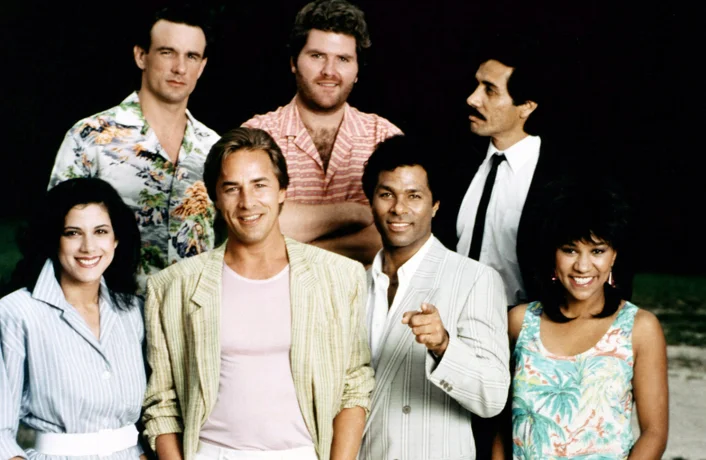
“Miami Vice” revolutionized television openings with a cinematic approach that looked more like a music video than a traditional TV intro, featuring neon-lit urban landscapes, exotic wildlife, and speed boats set to Jan Hammer’s electrifying instrumental theme. The quick cuts between flamingos, fast cars, and Art Deco architecture created a visual language that defined not just the show but an entire aesthetic that influenced fashion, design, and music throughout the decade. The absence of character shots until the very end was boldly unconventional, focusing instead on establishing Miami itself as perhaps the show’s most important character. Mental Floss has also uncovered additional facts about this series that are worth investigating while listening to the theme on repeat a couple dozen times.
The opening credits practically invented a new visual palette that would define the 1980s – pastels, sunsets, and sleek modern surfaces that still scream “eighties” to anyone who sees them. Don Johnson and Philip Michael Thomas appearing only in the final moments, dressed in their iconic casual blazers and t-shirts, was the perfect punctuation mark to an opening that prioritized mood over exposition. The sequence was so influential that it helped transform Miami’s own self-image, spurring restoration of the Art Deco district and revitalizing South Beach as tourists flocked to see the glamorous, dangerous city they’d fallen in love with through their television screens.
3. The A-Team (1983-1987)
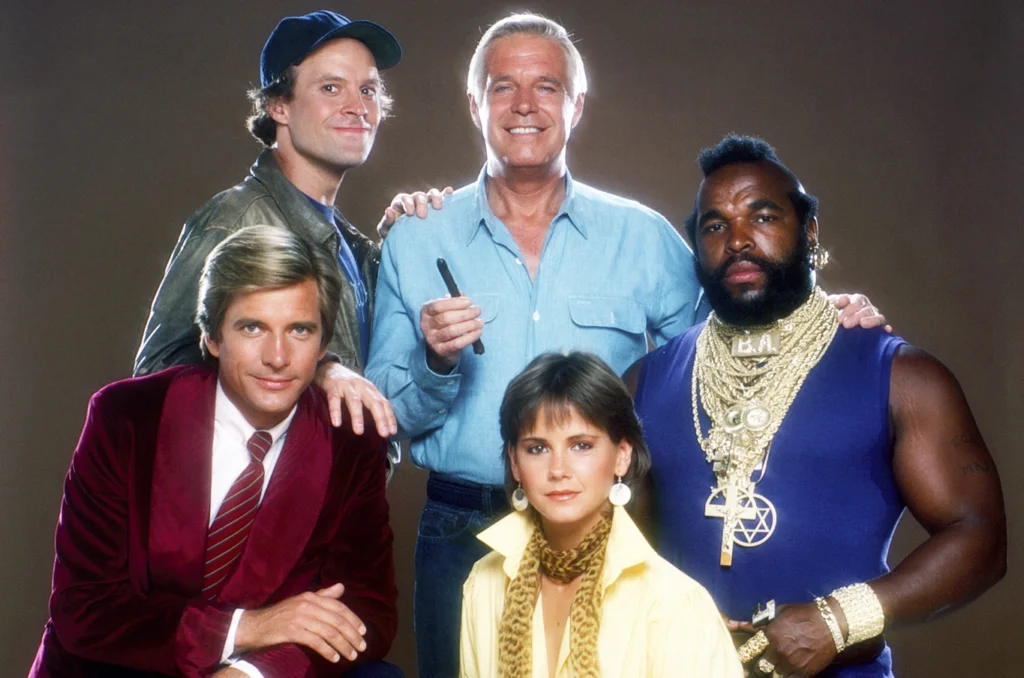
“The A-Team” opening credits took the military-style voiceover exposition to new heights, combining narrator explanation, character introductions, and an incredibly catchy theme song that had kids everywhere humming and mimicking the iconic opening guitar riff. The brilliant structure gave us the backstory (“In 1972, a crack commando unit was sent to prison for a crime they didn’t commit”), the premise (“they promptly escaped”), and the concept (“if you have a problem, if no one else can help…you can hire The A-Team”) all within the first 30 seconds. The rapid-fire action shots of explosions, helicopter stunts, and Mr. T’s scowl became a weekly adrenaline rush for viewers across America. As we near another big anniversary for the show, Truffle Shuffle has compiled some fascinating facts about the show, because everybody loves it when a plan comes together.
What made these credits stand out was how they efficiently served multiple purposes, introducing each character with signature moments that defined their personalities – Hannibal with a cigar and disguise, Face with a beautiful woman, Murdock doing something crazy, and B.A. Baracus flexing or looking tough. The sequence climaxed with the unforgettable image of the team’s van bursting through a wall of water, a perfect visual metaphor for how the show crashed through television conventions. For many viewers, the declaration that the team survived as “soldiers of fortune” living in “the Los Angeles underground” seemed so exciting that it made being a fugitive sound more like an adventure than a hardship.
4. Magnum, P.I. (1980-1988)
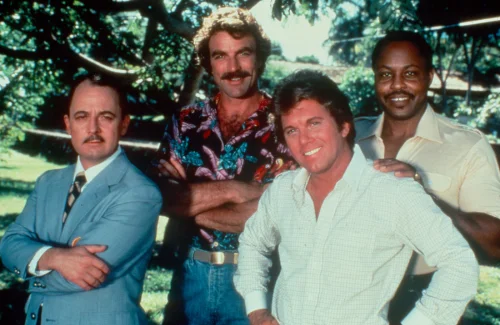
The “Magnum, P.I.” opening credits were a masterclass in character introduction, establishing Tom Selleck’s character as a Vietnam vet turned private investigator living an enviable life in Hawaii’s paradise. The sequence brilliantly juxtaposed Magnum’s serious military background (with quick flashes of helicopters and combat) against his current lifestyle of beautiful beaches, fast cars, and that iconic Detroit Tigers baseball cap. The visuals of Magnum speeding along coastal roads in his red Ferrari 308 GTS became one of the decade’s most recognizable images, while Mike Post and Pete Carpenter’s theme song perfectly balanced tension and tropical relaxation.
The credits were particularly clever in how they established the show’s supporting characters through brief vignettes – Higgins with his dobermans, TC with his helicopter, and Rick at his nightclub – all within seconds but giving viewers clear impressions of each personality. Nothing captured the 1980s male fantasy quite like this opening: the independent lifestyle, the cool job with no boss, the sports car, and the beautiful tropical setting all set to music that still makes viewers want to book a flight to Honolulu. The final shot of Selleck’s mustached smile became so iconic that it launched a thousand imitators, influencing men’s facial hair choices throughout the decade and establishing the actor as television’s definition of rugged charm.
5. Knight Rider (1982-1986)

“Knight Rider’s” opening sequence merged man and machine in revolutionary fashion, introducing both David Hasselhoff’s Michael Knight and the true star of the show – K.I.T.T., the artificially intelligent Trans Am with the distinctive red scanner light. The narrator’s iconic explanation that Knight was “a young loner on a crusade to champion the cause of the innocent” established the premise while Stu Phillips’ synthesizer theme became instantly recognizable with its pulsing electronic beat that mirrored K.I.T.T.’s scanner. The dramatic desert highway visuals and sleek car shots created a technological cool factor that had every kid dreaming of having their own talking car.
The genius of the sequence lay in how it treated the car as an equal character to Hasselhoff, giving K.I.T.T. just as much screen time and mystique as its human counterpart. The night shots of the black car with its red scanner cutting through darkness became an iconic visual that still appears in pop culture references decades later. For viewers in the early 1980s, this opening sequence represented a tantalizing glimpse into a future where technology could be our partner rather than just a tool – an idea that seemed revolutionary at the time but now feels prophetic as we talk to our smart devices daily.
6. The Golden Girls (1985-1992)
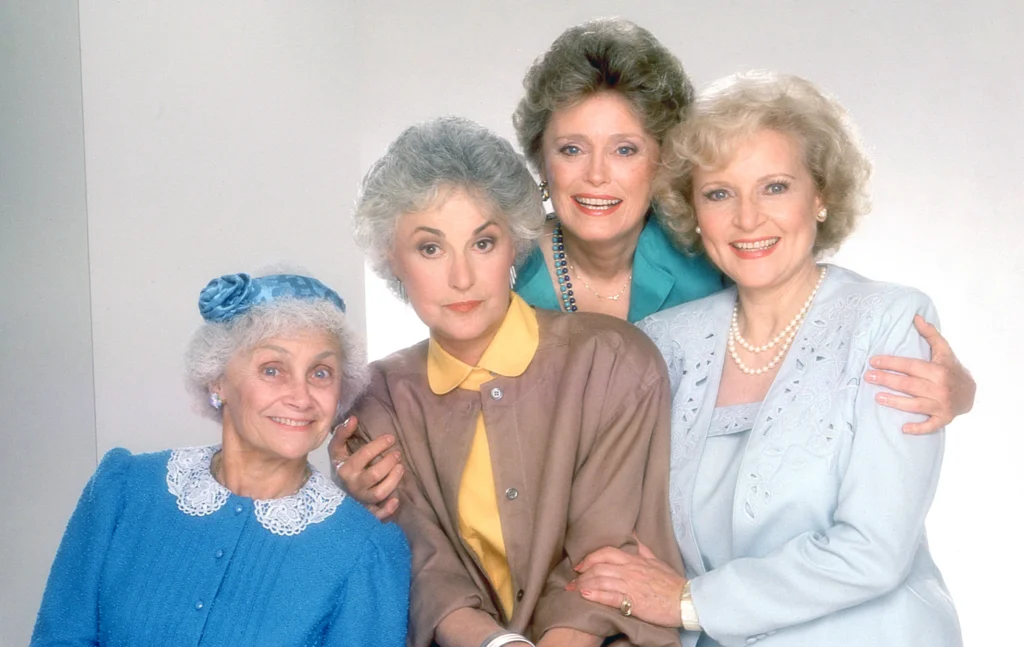
“The Golden Girls” opening credits worked magic by combining Andrew Gold’s pitch-perfect “Thank You For Being A Friend” with simple character introductions that established the show’s revolutionary premise: older women living together, supporting each other, and having active social lives. The sequence’s genius was in its simplicity – no fancy effects or action sequences, just warm shots of Bea Arthur, Betty White, Rue McClanahan and Estelle Getty showcasing their distinct personalities while engaging in everyday activities. The montage created an immediate sense of camaraderie among these very different women, making viewers feel they were being welcomed into a special friendship circle.
The credits quietly broke ground by presenting older women as vibrant, social, and fully-dimensional characters at a time when television rarely gave such roles to actresses over 50. The final dining room table scene, with the four women laughing and eating cheesecake, became an iconic image that represented the heart of the show – friendship as the family we choose. For millions of viewers who tuned in each week, that opening sequence wasn’t just an introduction to a sitcom; it was a comforting reminder that growing older didn’t mean growing less relevant, less interesting, or less capable of deep, meaningful relationships.
7. MacGyver (1985-1992)
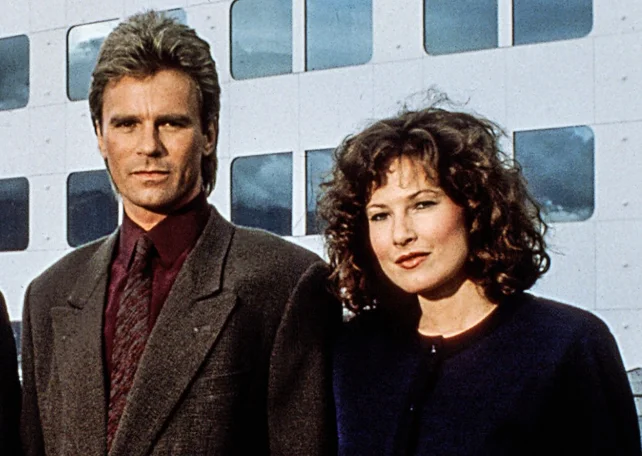
The “MacGyver” opening credits established Richard Dean Anderson’s character as an unconventional action hero through a series of quick vignettes showing him solving problems with everyday objects rather than guns or brute force. The fast-paced montage of MacGyver disarming bombs, creating makeshift tools, and escaping dangerous situations using science and ingenuity was perfectly matched with Randy Edelman’s energetic, percussion-heavy theme music. The sequence brilliantly communicated the show’s unique premise within seconds: this was an action hero who used his brain first and whose greatest weapon was his Swiss Army knife.
What made these credits particularly effective was how they demonstrated MacGyver’s problem-solving approach visually, showing his hands manipulating objects in close-up shots that emphasized creative thinking rather than violent solutions. The images of MacGyver creating improvised devices from household items became so iconic that “to MacGyver something” entered the cultural lexicon as a verb meaning to create ingenious solutions with limited resources. For a generation of viewers, these opening credits presented a new kind of hero who valued scientific knowledge and creativity, influencing countless young minds to see everyday objects as full of untapped potential.
8. Dallas (1978-1991)
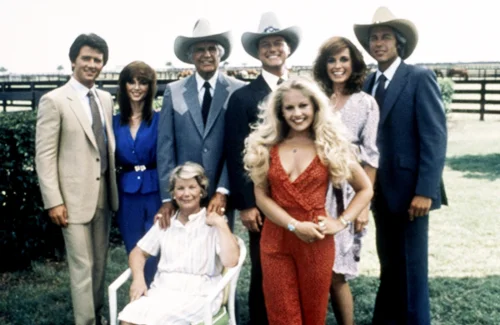
The “Dallas” opening sequence showcased the Texas oil metropolis with sweeping helicopter shots of gleaming skyscrapers, vast ranches, and oil derricks, creating a perfect visual representation of the show’s themes of wealth, power, and ambition. Jerrold Immel’s unforgettable theme music – with its distinctive horns and driving rhythm – captured both the grandeur and the tension underlying the Ewing family saga. The split-screen effects transitioning between Dallas landmarks and character shots was innovative for its time, allowing viewers to connect the characters to their environment while establishing the city itself as a character in the drama.
The genius of the sequence was how it communicated the show’s epic scale, making a family drama feel as significant and sweeping as any western or historical saga. The quick character shots – often showing the Ewings in moments of contemplation or conflict – created visual shorthand for the complex relationships that drove the series’ legendary plotlines. For viewers in the economically ambitious 1980s, the opening’s images of wealth and success perfectly captured the decade’s aspirational spirit, making the cutthroat world of Texas oil seem glamorous despite the moral compromises it required of the characters.
9. The Greatest American Hero (1981-1983)
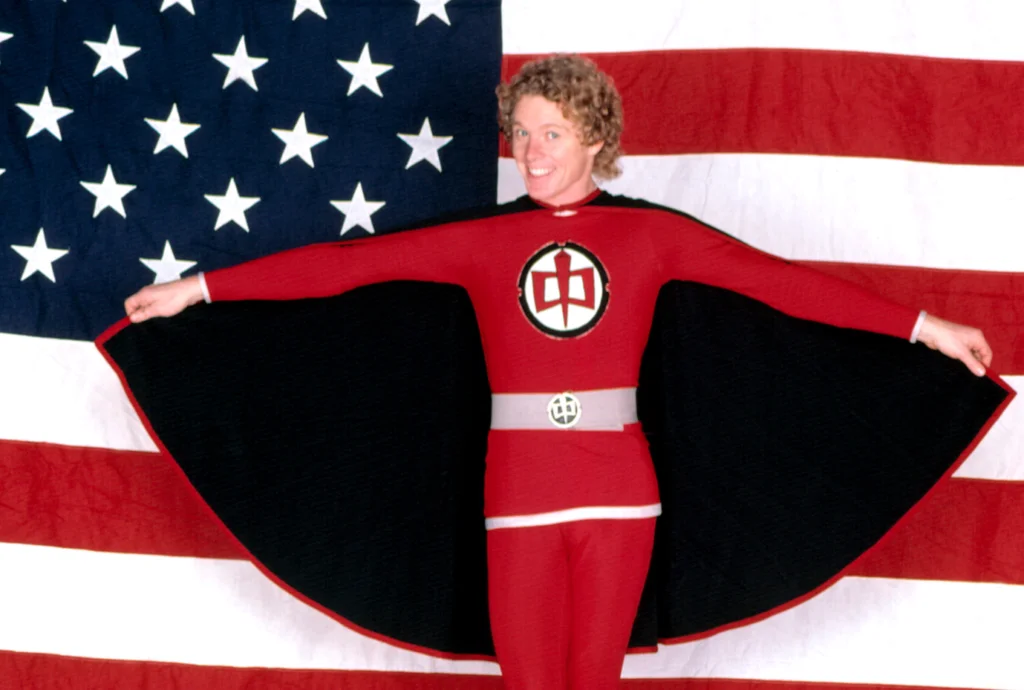
“The Greatest American Hero” opening credits perfectly captured the show’s unique blend of superhero tropes and fish-out-of-water comedy, showing ordinary teacher Ralph Hinkley (William Katt) struggling hilariously to master his alien-gifted supersuit. Joey Scarbury’s chart-topping theme song “Believe It or Not” provided the perfect soundtrack, with lyrics about “walking on air” that contrasted humorously with the visual gags of Katt crashing into walls and tumbling through the sky. The sequence brilliantly established the show’s central premise – that having superpowers doesn’t automatically make you competent at using them – through a montage that was equal parts inspirational and comedic.
What made these credits truly special was how they captured the everyman quality of the protagonist, showing a regular guy with curly hair and glasses rather than a chiseled traditional hero, making the fantasy accessible to viewers who might imagine themselves in similar circumstances. The final triumphant moments of the sequence, when Ralph finally masters some of his flying abilities, created a satisfying narrative arc within the credits themselves. Though the show only ran for three seasons, the opening became so beloved that the theme song climbed to #2 on the Billboard Hot 100, and the image of Ralph awkwardly flying became one of television’s most endearing superhero moments, influencing later productions that similarly humanized the superhero experience.
10. St. Elsewhere (1982-1988)
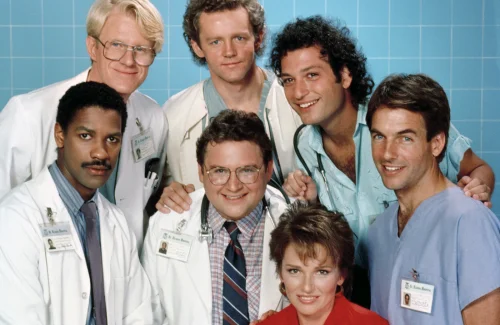
“St. Elsewhere’s” opening credits brilliantly juxtaposed gentle flute music with stark images of Boston’s deteriorating South End neighborhood before revealing the rundown St. Eligius Hospital, immediately establishing the show’s central setting as an underfunded facility serving a struggling community. The sequence showed the dedicated medical staff arriving for work while intercut with patient moments, creating an immediate emotional connection to both the caregivers and those they served. Dave Grusin’s theme music evolved throughout the sequence, incorporating jazz and classical elements that reflected the show’s sophisticated approach to television drama.
The credits perfectly captured the show’s groundbreaking blend of medical cases, dark humor, and social commentary through visuals that never romanticized medicine but instead showed its everyday reality. Rather than glamorizing doctors as many medical shows did, the opening humanized them by showing simple moments: changing clothes, walking corridors, examining X-rays, and interacting with patients from diverse backgrounds. For viewers accustomed to television hospitals that looked like gleaming temples of healing, “St. Elsewhere’s” opening presented a more truthful alternative – a place where dedicated professionals worked against the odds in a facility that, like many urban hospitals of the time, struggled with limited resources but unlimited compassion.
11. Moonlighting (1985-1989)
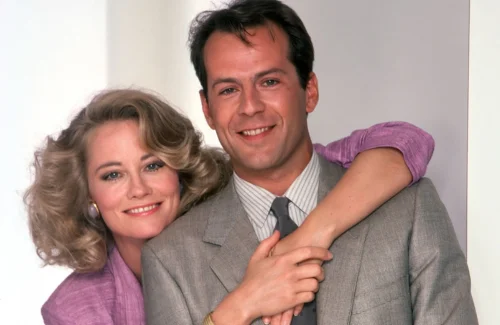
The “Moonlighting” opening credits broke the fourth wall before breaking the fourth wall was cool, with Bruce Willis and Cybill Shepherd appearing as themselves rather than their characters, creating an immediate sense of playfulness and meta-humor. Al Jarreau’s jazzy theme song, with its scatting vocal style and references to “Moonlighting strangers,” perfectly captured the show’s noir-inspired detective stories and the verbal sparring between the leads. The sequence was revolutionary in how it focused entirely on establishing the chemistry between Willis and Shepherd rather than explaining the premise, trusting that their dynamic would be enough to hook viewers.
The black-and-white photography with subtle blue accents created a visual callback to classic films while still feeling thoroughly modern, much like the show itself which reinvented detective stories for a new generation. The credits’ most innovative aspect was how they changed subtly each season, reflecting the evolving relationship between the characters and acknowledging the show’s own growing popularity as Willis transitioned from unknown actor to movie star during its run. For viewers in the mid-80s, these opening credits signaled something entirely new on television – a show that was self-aware, stylistically ambitious, and built around crackling dialogue and romantic tension rather than action sequences.
12. Airwolf (1984-1987)
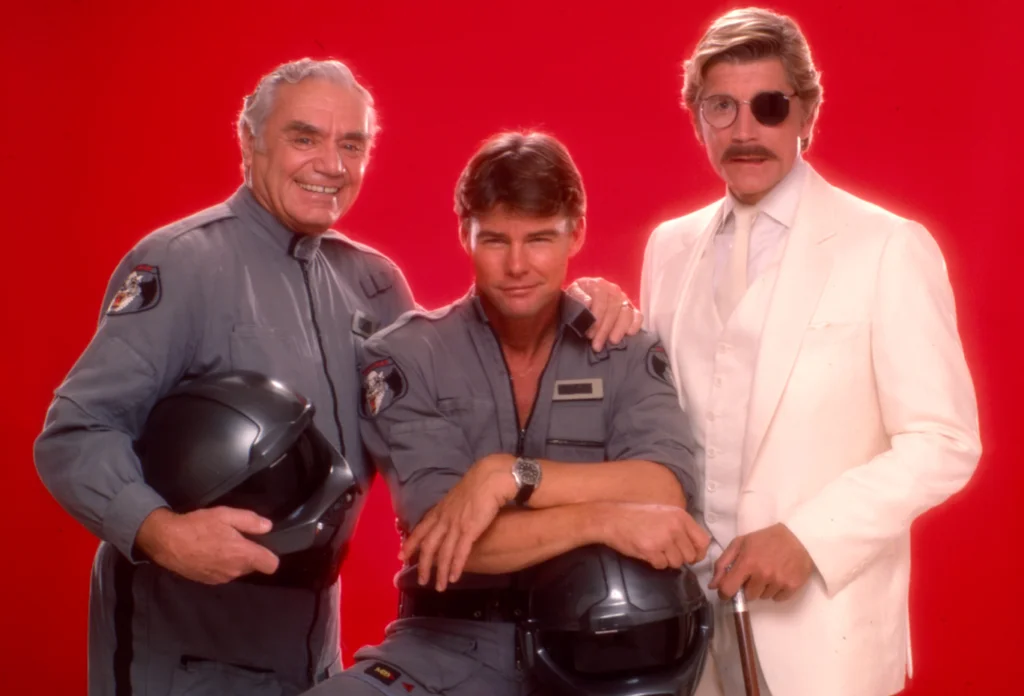
The “Airwolf” opening credits elevated the helicopter to mythic status through a combination of dramatic desert photography and Sylvester Levay’s unforgettable synthesizer score that built to an adrenaline-pumping crescendo. The sequence brilliantly established the show’s central character – not Jan-Michael Vincent’s Stringfellow Hawke, but the sleek, supersonic military helicopter itself – through loving shots of the aircraft emerging from its hidden lair in the Valley of the Gods. The dramatic lighting and camera angles transformed what could have been standard airplane footage into something almost supernatural, with Airwolf rising from its cave like a mechanical dragon awakening.
The genius of these credits was how they created a sense of ceremony around the helicopter’s deployment, showing the meticulous pre-flight checks and pilot preparations that emphasized Airwolf as something extraordinary and almost sacred. The sequence reaches its climax as the helicopter finally takes flight, roaring across the stark landscape while the theme music reaches its full electronic grandeur. For a generation of viewers, these opening credits represented the perfect marriage of 1980s technological fascination and Cold War military fantasy, offering the weekly thrill of seeing an American superweapon deployed for justice rather than destruction.
As we look back at these television time capsules, it’s clear they were much more than just introductions – they were cultural artifacts that helped define the decade and remain powerful nostalgia triggers decades later. These opening sequences didn’t just tell us who starred in the shows or establish basic premises; they created emotional connections that kept us coming back week after week. In today’s era of streaming and binge-watching, the art of the opening credit sequence continues to evolve, but for those of us who grew up waiting eagerly for these weekly rituals, nothing will ever quite compare to the anticipation we felt when we heard those first few notes of our favorite ’80s TV themes.


